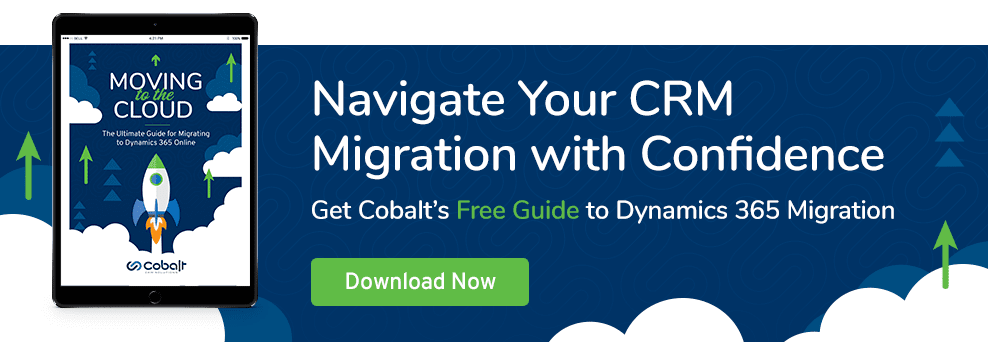Dynamics CRM data migration projects aren’t easy for many companies because they are nervous — with good reason — about the security and integrity of their data.
But it’s not just scary to get all the data moved over securely. Dynamics CRM data migrations from on-premises CRM solutions to cloud-based CRM systems like Dynamics 365 can be very complex.
In this post I’ll touch on the most common mistakes companies make with these kinds of projects (spoiler alert: it’s almost always about how you deal with old data).
Take a copy of our CRM Migration Guide for your team today.
If you’d like a little more on the challenges and opportunities that come with migrating, check out this 10-minute interview on PartnerTalks with Microsoft MVP Rick McCutcheon. Rick talks with Cobalt CEO Russ Inman about some of the priorities you should be working through in this transition.
Let’s take a quick look at what will be most important for your team’s Dynamics CRM Data Migration project.
Dynamics CRM Data Migrations: How Much Data Do You Need?
Cobalt has been deep in the weeds and details of CRM data migration with hundreds of teams over the years. When companies in our core industries come to us for cloud migration services or one of our Dynamics 365 implementation packages, there are some CRM data migration questions that always come up.
And the biggest one is: how much data do you need to move online?
There are always exceptions, obviously, and there isn’t a single answer for every organization. But there is one trusted principle we come back to time and again as we advise our clients: only take the data you actually use.
The most common temptation (and pitfall) for companies is to just move everything they have from their on-premises system to their cloud-based CRM. All that data was hard-won, expensive to accumulate, and valuable (at least when you gathered it). And after all, you just never know if we might need it later …
That’s how the rationalization for a massive migration of everything you’ve ever collected often goes. There are three significant drawbacks to this approach.
3 Drawbacks of a Massive CRM Data Migration
Documentation
It’s rare — very rare — that we meet a team that has diligently, meticulously, and consistently kept up with all the changes they’ve made to their on-premises instance of Dynamics CRM. You almost certainly have third-party solutions, custom code, incomplete lists of fields and entities, and ad hoc alterations to the data relationships.
The good news is that all of these things are easier or just aren’t an issue once your CRM is in the cloud. The bad news facing you now … is that all of these changes and the missing documentation could be a very big deal.
The older the data, the more likely that the documentation is lost or impossible to retrieve. Being more selective about the data you migrate — and only bringing what you need today — reduces the amount of leg work you or a vendor needs to do to try and gather documentation in this process.
Complexity
This drawback is fairly straight forward: bigger migrations often bloat the complexity of your CRM data migration project and increase the likelihood that you’ll need some highly specialized migration assistance.
We’ll touch on the cost factor(s) in a moment, but for now, consider the extra time and involvement from your team and then ask how much that old, unused data is really worth today, or next year. Sometimes just framing it that way is a helpful guide in deciding what to keep and what to leave.
Cost
CRM data migration projects can become very costly as the complexity grows, the timeline extends, and the amount of custom mapping expands. All of that quickly runs up the cost of your CRM data migration on the frontend. But that’s not all, unfortunately.
CRM data storage comes at a cost in the cloud, as well. This means that moving huge amounts of legacy data “just in case” could bloat your ongoing monthly costs for your cloud-based CRM over time, as well.
Moving to Dynamics 365 online is almost always a better move from a cost perspective. But the cost savings you’re likely to see could evaporate quickly if your online data storage costs skyrocket with huge amounts of non-essential data.
It’s a related topic for another post — but let’s quickly mention that new D365 online users should probably take the time to rethink what kinds of files, attachments, and other items really fit into the “essential” category. Considering your CRM data migration and storage costs is a great incentive to take that seriously.

Connect With a CRM Expert for SMBs
When you’re ready to start the conversation about your organization’s needs and what Microsoft Dynamics 365 can do for your team, let’s connect for a quick call and free assessment.
The Hidden Opportunity in Your Dynamics CRM Data Migration Project
Cleaning Your CRM Data
If you’re still running Dynamics CRM on-premises, you’ve almost certainly been weighing the benefits of moving to Dynamics 365 Online for a while and delaying a project like this for good reasons. The challenges are real, but let’s highlight one additional benefit related to Dynamics CRM data migration on your way to the cloud now.
Why haven’t you prioritized cleaning your CRM data? If you’re like virtually every other organization out there … it’s because there’s never a good time to stop and clean your CRM data.
But, it turns out, a CRM data migration on your way to the cloud is the perfect time to tackle that essential housekeeping.
Dynamics 365 online unlocks enormous value for your team with all the integrations that are now possible, instant updates, highly advanced, additional tools through the Power Platform, and on and on.
Don’t overlook the prime opportunity to take a careful look at your CRM data, make sure you’re keeping and looking at the right pieces of the picture, and let go of what you don’t need.
Even better, we’ve got a brand new post that will walk your team through some very practical ways clean CRM data: 2023 CRM Data Management: Clean Data, Clear Sales Insights.
Dynamics CRM Data Migration Expertise
I hope these considerations about how you handle your Dynamics CRM data migration plan are helpful to you. Here are some other related CRM migration resources from our team at Cobalt that has pulled off 200+ seamless, secure migrations with zero downtime.
- CRM Migration Guide
- Must-Ask Questions Before Migrating to Dynamics 365 Online
- Dynamics 365 vs Salesforce: Price and Value Comparison
- Salesforce to Dynamics 365 Migration: 5 Critical Issue
If you’re weighing the pros and cons of attempting a Dynamics CRM data migration project as an in-house project, it’s definitely doable, but there are some serious hidden pitfalls along the way. Read about the four most common ones in our CRM Migration Guide for Dynamics 365 now.
Our guide also distills three of the biggest reasons Cobalt’s clients choose us for a Dynamics 365 CRM data migration partner:
- our fixed-cost pricing
- the iterative process we’ve refined
- the no-hassle free evaluation to start the project

